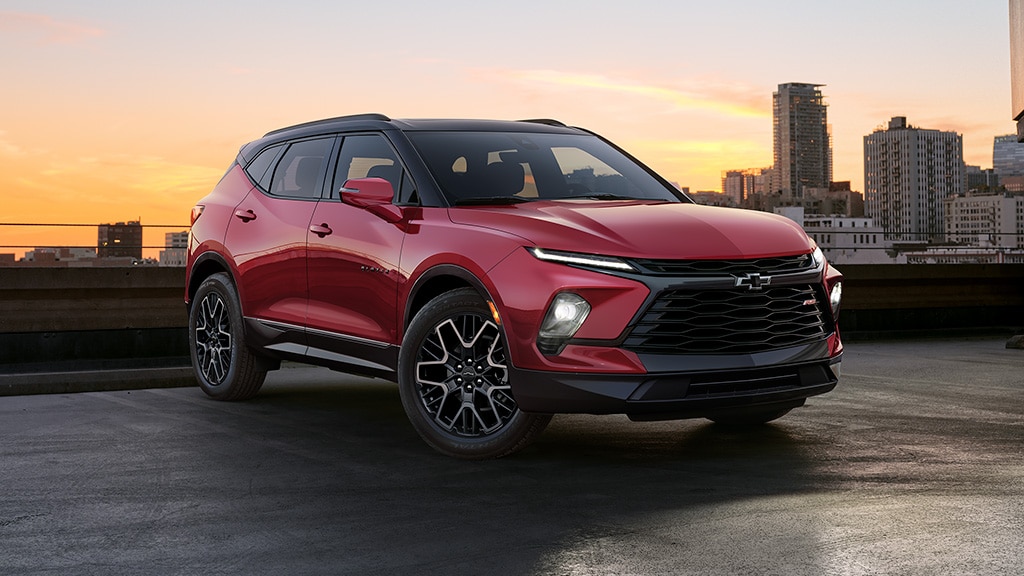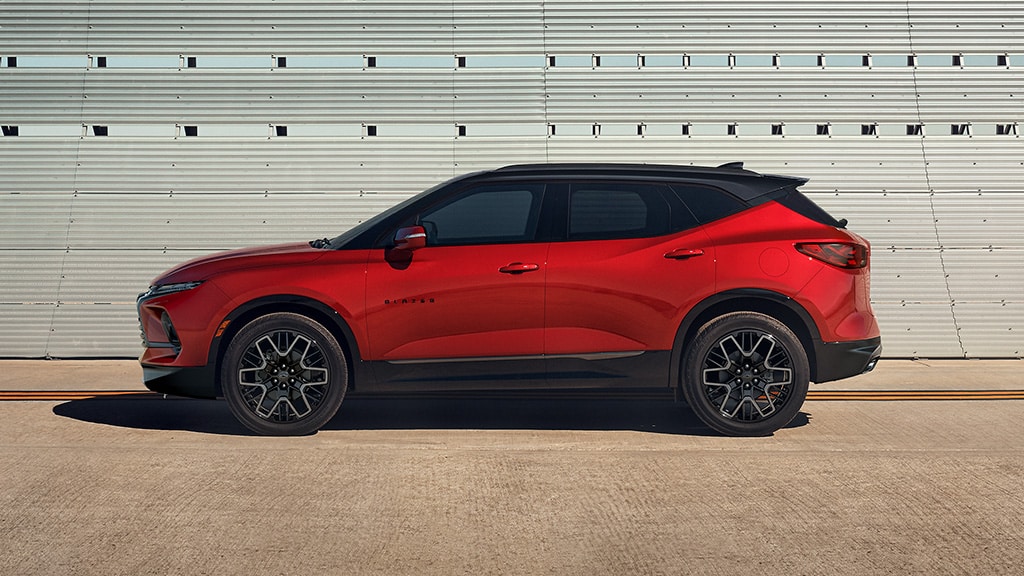2026 Chevrolet Blazer
2026 Chevrolet Blazer Preview
Updated October 09, 2025
Pros
- Attractive style
- Available V6
- Easy-to-use infotainment
Cons
- Some cost-cutting cabin materials
- Cargo space lacking
What's New?
- Premier trim line dropped
- V6 is exclusively optional in the RS trim
The 2026 Chevrolet Blazer is a 2-row midsize SUV with a sporty edge, responsive handling, and two engine options.
In a class where most designs blur together, the Blazer stands out. Its lines borrow heavily from Chevy’s sports cars, and though this look debuted in 2019, it still feels fresh — especially as rivals chase boxy, off-road vibes. Inside, you’ll find an intuitive infotainment system, and if you want more muscle, there’s an optional V6.
Cargo space? That’s where the Blazer comes up short. A Honda Passport or even a Toyota RAV4 will haul more. But passenger space in both rows is generous.
The midsize 2-row SUV field is crowded with solid choices, but the Blazer is among the most stylish options.
Chevy also offers an all-electric Blazer EV, which we review separately.
We’ve logged hundreds of hours behind the wheel of this generation of midsize SUVs, including the Blazer.
What's New for 2026
The Chevy Blazer drops the Premier trim level for 2026. Also, the turbo 4-cylinder engine is now standard on every trim. The available V6 is now exclusively optional in the RS trim, where it used to be standard.
Chevrolet Blazer Pricing
The Blazer starts at $36,095, a $1,000 discount from last year’s base model, with the RS trim beginning at $45,395.
| Trim | MSRP (including destination fee) |
| Blazer 2LT FWD | $36,095 |
| Blazer 2LT AWD | $38,795 |
| Blazer 3LT FWD | $41,495 |
| Blazer 3LT AWD | $44,195 |
| Blazer RS FWD | $45,395 |
| Blazer RS AWD | $48,295 |
The base 2LT is the best-selling trim, and it comes with wireless Apple CarPlay and Android Auto, dual-zone climate control with rear vents, and heated front seats, plenty of tech and comfort for most buyers. If you’re looking for leather seating, that’s reserved for the RS, which has an optional V6.
The Blazer sits toward the lower end of segment pricing, with rivals often costing thousands more.
Before you buy a new midsize SUV, check Kelley Blue Book’s Fair Purchase Price. The Blazer’s resale value is below average. The Honda Passport, Jeep Grand Cherokee, and Toyota 4Runner hold value better, and that matters when it’s time to trade in.
Power, Ride, and Handling
The Blazer’s core powertrain is a 228-hp turbocharged 4-cylinder paired with a 9-speed automatic transmission. Front-wheel drive (FWD) is standard, and all-wheel drive (AWD) is available on every trim.
The turbocharged 4-cylinder suits the Blazer’s weight, delivering a zero-to-60-mph time just over six seconds and plenty of passing power.
Steering feels well weighted, and while no midsize SUV is a sports car, the Blazer corners with more confidence than most, and the braking inspires trust. The suspension strikes a sweet balance, being soft enough for comfort, yet firm enough to stay composed in quick corners.
The Blazer’s cabin is quiet, though not quite luxury-vehicle quiet, thanks to active noise cancellation, which does an admirable job on wind and road noise.
The available V6 is an option only with the RS trim. It transforms the Blazer from sporty to genuinely quick. The bigger engine is certainly a worthy upgrade for some, but most buyers will be happy with the 4-cylinder.
Fuel Economy
EPA ratings for front-wheel-drive, 4-cylinder Blazers: 22 mpg city/29 highway/25 combined. All-wheel drive drops those figures to 22/27/24.
The V6 reduces efficiency, but not too much: front-wheel drive gets 19/26/22, and all-wheel drive nets 18/26/21.
Comfortable Interior
Most trims feature a traditional gauge cluster, but the RS adds a digital display. A 10.2-inch touchscreen sits high on the dash for infotainment, with separate climate controls below — no hunting through menus to change the temp.
Many new models merge multiple screens into one wide panel, but we like Chevy’s split setup. It keeps everything visible and easy to reach, and your hands don’t block your view of important information.
Chevy may have retired the Camaro, but its design DNA lives on here. Turbine-style vents add flair, and RS trims tint them to match interior accents.
Rear-seat space beats the Chevy Equinox, with standout legroom. Sunroof-equipped models offer better headroom than many rivals, which is handy if you’re hauling adults or taller teens often.
Our main gripe? Cargo space. At 30.5 cu ft behind the second row, the Blazer ranks near the bottom of its class. Fold the seats and there’s plenty of space, but most competitors offer more room with seats up.
Muscular Exterior
Chevy borrowed from the sporty and aggressive Camaro design language for the Blazer’s exterior look. While rivals chase rugged, boxy styling, the Blazer remains the sportiest-looking midsize two-row SUV at non-luxury prices.
Our Favorite Features and Tech
10.2-inch infotainment system
Average size these days, but Chevy’s interface is intuitive. Wireless Android Auto and Apple CarPlay come standard.
Standard remote start
Every Blazer trim includes it — rare in this segment and a lifesaver in cold climates.
Chevy Safety Assist
Standard suite includes automatic emergency braking, lane-keep assist, following distance indicator, and auto high beams. Options add adaptive cruise, blind-spot monitoring, and rear cross-traffic alert.
Two engine options
Few rivals offer a choice. A V6 is starting to become a rarity in this segment, and we appreciate that there’s still one available in the Blazer.
Sporty RS trim
The Blazer’s bold look gets backup from an optional 308-hp V6, blacked-out emblems, unique wheels, and black leather with red accents.
Midnight Edition
The Midnight Edition adds black trim and wheels, bringing a darker aesthetic to the stylish Chevy Blazer.
Engine and Transmission
Chevrolet gives Blazer buyers two engine choices, both paired with a 9-speed automatic. Front-wheel drive is standard, and all-wheel drive is available with either engine.
The 228-hp turbocharged 4-cylinder is the volume seller and the right pick for most. It delivers easy cruising and solid fuel economy without breaking a sweat.
Want more punch? The 308-hp V6 is your ticket. It costs more and sips a bit more fuel, so it’s best for those who value speed enough to accept the tradeoffs.
3-Year/50,000-Mile Warranty
Chevy’s coverage is typical for a mainstream brand. The bumper-to-bumper warranty runs three years or 36,000 miles, whichever happens first. The powertrain gets five years or 60,000 miles. Scheduled maintenance is covered for the first year, but don’t weigh that heavily, as modern cars need little service early on, so the savings are minimal.
Safety Ratings
The National Highway Traffic Safety Administration (NHTSA) gave the 2025 Blazer its top overall score of 5 Stars, and the 2026 model is essentially identical, so it should also fare well. The Insurance Institute for Highway Safety (IIHS) hasn’t fully tested the latest models yet, but the mechanically identical 2024 earned “Good” marks.
Cars You May Like
We’ve Rounded Up Cars That Could Be Your Perfect Match.
2026 Chevrolet Blazer
KBB.com Consumer Reviews
Trending Topics in KBB.com Consumer Reviews
Calculate Your Budget With These KBB.com Tools
Specifications
Dimensions, Weights & Capacities
Curb Weight | 3918 lbs. | ||
|---|---|---|---|
EPA Passenger | 107.8 cu.ft. | ||
Fuel Capacity | 19.4 gallons | ||
Front Head Room | 39.8 inches | ||
Front Leg Room | 41.0 inches | ||
Max Seating Capacity | 5 | ||
Minimum Ground Clearance | 7.5 inches | ||
Overall Length | 191.9 inches | ||
Front Shoulder Room | 59.1 inches | ||
Towing Capacity, Maximum | 1500 lbs. | ||
Trunk or Cargo Capacity | 64.2 cu.ft. | ||
Turning Diameter | 38.7 feet | ||
Wheel Base | 113.0 inches | ||
Gross Vehicle Weight Rating (GVWR) | 6001 lbs. |
Exterior
Alloy Wheels | Available | ||
|---|---|---|---|
Number of Doors | 4 doors | ||
Privacy Glass | Available | ||
Roof Rails | Available | ||
LED Headlights | Available |
Fuel Economy
City | 22 mpg | ||
|---|---|---|---|
Highway | 29 mpg | ||
Combined | 25 mpg |
Mechanical
Drivetrain | FWD | ||
|---|---|---|---|
Transmission Type | Automatic | ||
9 speed | Available | ||
Recommended Fuel | Regular | ||
Parking Assist System | Available |
Performance
Horsepower | 228 @ 5000 RPM | ||
|---|---|---|---|
Torque | 258 @ 1500 rpm | ||
Engine | 4-Cyl, Turbo, 2.0 Liter |
Warranty
Basic | 3 years / 36000 miles | ||
|---|---|---|---|
Powertrain | 5 years / 60000 miles | ||
Corrosion | 3 years / 36000 miles |
Comfort & Convenience
Entertainment
Interior
Seating
Security
Technology
2026 Chevrolet Blazer Safety
Safety Features & Technology
Crash Test Rating
Compare to Similar Vehicles
 New Chevrolet Blazer |  New 2026 Ford Expedition MAX |  New 2026 Ford Expedition |  New 2026 Kia Sorento Hybrid | ||
|---|---|---|---|---|---|
| Price | $37,095 | $67,515 | $64,515 | $40,105 | |
| KBB.com Rating | 3.8 | 4.8 | 4.8 | 4.7 | |
| Consumer Rating | 4.3 | 4.0 | 4.0 | 4.0 | |
| Fuel Economy | City 22/Hwy 29/Comb 25 MPG | N/A | City 16/Hwy 24/Comb 19 MPG | City 36/Hwy 36/Comb 36 MPG | |
| Fuel Type | Gas | Gas | Gas | Hybrid | |
5 Year Cost To Own 5-Year Cost to Own includes out of pocket expenses like fuel and insurance, plus the car’s loss in value over time (depreciation). | $58,420 | N/A | $82,516 | $58,732 | |
| Safety Rating | 5.0 | N/A | N/A | N/A | |
| Seating Capacity | 5 | 8 | 8 | 6 | |
| Basic Warranty | 3 years or 36000 miles | 3 years or 36000 miles | 3 years or 36000 miles | 5 years or 60000 miles | |
| Horsepower | 228 @ 5000 RPM | 400 @ 5200 RPM | 400 @ 5200 RPM | 227 @ 5500 RPM | |
| Engine | 4-Cyl, Turbo, 2.0 Liter | V6, EcoBoost, 3.5 Liter | V6, EcoBoost, 3.5 Liter | 4-Cyl, Hybrid, Turbo, 1.6 Liter | |
| Drivetrain | FWD | 2WD | 2WD | FWD |
Best SUVs
More Chevrolet Blazer News & Information
A new report says General Motors will not cancel the gas-powered Chevy Blazer and Cadillac XT5 as previously reported.
A new report says Chevrolet will drop the gas-powered Blazer from its lineup after 2025, keeping only the electric version.
General Motors (GM) has already announced its intention to build, sell, and donate Ultium-branded chargers. The need for more electric…
FAQs
Will GM make a 2026 Chevrolet Blazer?
Yes, despite rumors of its demise, the gasoline-powered Chevrolet Blazer will be back for the 2026 model year.
Will there be a 2027 Chevy Blazer?
Yes, the 2027 Chevrolet Blazer is expected to be built at the brand’s plant in Spring Hill, Tennessee, likely as it enters an all-new generation. The 2026 Blazer is currently built at the company’s plant in Ramos Arizpe, Mexico.
Which is bigger, Equinox or Blazer?
The Blazer is slightly larger than the Equinox, but the difference may be smaller than you’d expect. The Equinox, for instance, offers 29.8 cubic feet of cargo space behind the rear seats, while the Blazer offers 30.5 cubic feet. The Blazer is also somewhat larger in its exterior dimensions than the Equinox.
Is the 2026 Chevrolet Blazer reliable?
The 2026 Chevrolet Blazer is part of the 1st-generation Blazer, which our owners give an above-average reliability rating of 4.5 out of 5.







